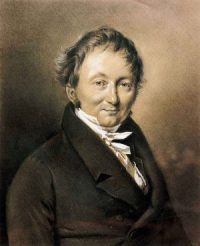
Drais was a prolific inventor, who invented the Laufmaschine (“running machine”), also later called the Velocipede, Draisine (English) or draisienne (French), also nicknamed “the hobby horse” or “dandy horse”. This was his most popular and widely recognized invention. It incorporated the two-wheeler principle that is basic to the bicycle and motorcycle and was the beginning of mechanized personal transport.
Karl von Drais on his original Laufmaschine, the earliest two-wheeler, in 1819
This was the earliest form of a bicycle, without pedals. His first reported ride from Mannheim to the “Schwetzinger Relaishaus” (a coaching inn, located in “Rheinau”, today a district of Mannheim) took place on 12 June 1817 using Baden’s best road. Karl rode his bike; it was a distance of about 7 km (4.3 mi). The round trip took him a little more than an hour, but may be seen as the big bang for horseless transportation. However, after marketing the Velocipede it became apparent that roads were so rutted by carriages that it was hard to balance on the machine for long, so Velocipede riders took to the sidewalks and moved far too quickly, endangering pedestrians. Consequently, authorities in Germany, Great Britain, the United States, and even Calcutta banned its use, and after its brief moment in the limelight, the dandy-horse quickly faded into oblivion.
Drais also invented the earliest typewriter with a keyboard (1821). He later developed an early stenograph machine which used 16 characters (1827), a device to record piano music on paper (1812), the first meat grinder, and a wood-saving cooker including the earliest hay chest. He also invented two four-wheeled human powered vehicles (1813-1814), the second of which he presented in Vienna to the congress carving up Europe after Napoleon’s defeat. In later years he developed a foot-driven human powered railroad vehicle (1840) whose name “Draisine” is used even today for railroad handcars.
Drais was unable to market his inventions for profit because he was still a civil servant of Baden, even though he was being paid without providing active service. As a result, on 12 January 1818, Drais was awarded a grand-ducal privilege (Großherzogliches Privileg) to protect his inventions for 10 years in Baden by the younger Grand Duke Karl. Grand Duke Karl also appointed Drais Professor of Mechanics. This was merely an honorary title, not related to any university or other institution. Drais retired from the civil service and was awarded a pension for his appointment to Professor for Mechanical Science.
Иeing the fervent radical, Drais gave up his title of Baron in 1849б and dropped the “von” from his name. Subsequently, after the revolution collapsed, he was in a very bad position. The royalists tried to have him certified as mad and locked up. His pension was confiscated to help to pay for the “costs of revolution” after it was suppressed by the Prussians.
Karl Drais died penniless on 10 December 1851 in Karlsruhe. The house in which he lived last is just two blocks away from where at that time young Carl Benz was raised.
Related articles:
Coffee Filter Invention: Melitta Bentz’s Revolution
German Women – Scientists and Inventors
Amalie Emmy Noether: The Revolutionary Mathematician
Rudolf Diesel, His Invention and Mysterious Death
Carl von Linde Who Gave the World the Refrigerator
Katharina Paulus
